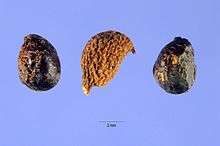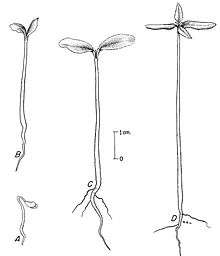Zanthoxylum americanum
| Zanthoxylum americanum | |
|---|---|
 | |
| Zanthoxylum americanum at the Real Jardín Botánico de Madrid | |
| Scientific classification | |
| Kingdom: | Plantae |
| (unranked): | Angiosperms |
| (unranked): | Eudicots |
| (unranked): | Rosids |
| Order: | Sapindales |
| Family: | Rutaceae |
| Genus: | Zanthoxylum |
| Species: | Z. americanum |
| Binomial name | |
| Zanthoxylum americanum Mill. | |
 | |
| Natural range | |
Zanthoxylum americanum, the common prickly-ash, common pricklyash, common prickly ash or northern prickly-ash (also sometimes called toothache tree, yellow wood, or suterberry), is an aromatic shrub or small tree native to central and eastern portions of the United States and Canada. It is the northernmost New World species in the citrus (Rutaceae) family, and is part of the same genus as sichuan pepper.[1] It can grow to 10 meters (33 ft) tall with a diameter at breast height (DBH) of 15 cm (5.9 in).[2] It produces membranous leaflets and axillary flower clusters.[2] The wood is not commercially valuable, but oil extracts from the bark have been used in traditional and alternative medicine, and have been studied for antifungal and cytotoxic properties.[2] The genus name is sometimes spelled Xanthoxylum.
Taxonomy
Originally described by Scottish botanist Philip Miller in 1768,[3] Zanthoxylum americanum is a member of the wide-ranging genus Zanthoxylum in the plant family Rutaceae, which includes many species with aromatic foliage. Miller, who spelled the name Xanthoxylum, described the plant in the eighth edition of his Gardeners Dictionary, as "grow[ing] naturally in Pensylvania [sic] and Maryland".[4]
Description
The plant has pinnately compound leaves with 5–11 membranous leaflets. It has axillary flower and fruit clusters.[2] The buds are hairy. The dark green leaves are bitter-aromatic, with crenate margins.[2][5] The stalked follicles are green and then turn red[5] through deep blue through black.[2][6] Flowers are dioecious, with yellow-green petals.[7]
Distribution and conservation status

Rare in the South, it is more common in the northern United States.[2] In the United States, it occurs in Alabama, Arkansas, Connecticut, Delaware, the District of Columbia, Florida, Georgia, Iowa, Illinois, Indiana, Kansas, Kentucky, Louisiana, Massachusetts, Maryland, Maine, Michigan, Minnesota, Missouri, North Carolina, North Dakota, Nebraska, New Hampshire, New Jersey, New York, Ohio, Oklahoma, Pennsylvania, Rhode Island, South Carolina, South Dakota, Tennessee, Virginia, Vermont, Wisconsin and West Virginia; the species also occurs in Ontario and Quebec in Canada.[8] The species is listed as Endangered in Florida, Maryland, and New Hampshire; and as Special Concern in Tennessee.[8]
Butterflies that use Zanthoxylum americanum as a larval food source include the Thoas swallowtail (Papilio thoas), giant swallowtail (P. cresphontes), and spicebush swallowtail (P. troilus).[5]
This plant was discovered by John Bartram in his travels and plant collecting excursions.
Medicinal use

Traditional
An oil extracted from the bark and follicles of the prickly-ash (both this species and Zanthoxylum clava-herculis) has been used in herbal medicine.[2][6] The extract may act as a stimulant, and historic medicinal use has included use "for chronic rheumatism, typhoid and skin diseases and impurity of the blood..." as well as for digestive ailments.[6] Grieve states, "The berries are considered even more active than the bark, being carminative and antispasmodic, and are used as an aperient and for dyspepsia and indigestion; a fluid extract of the berries being given, in doses of 10 to 30 drops."[6] The bark has been chewed for toothaches, and a tea from the follicles has been used for sore throats and as a diuretic.[9] As noted by Michael Dirr, in his Manual of Woody Landscape Plants, "Supposedly the stems and fruits were chewed by the Indians to alleviate toothache for the acrid juice has a numbing effect."
Modern studies and uses
There have been some modern studies of the oil's chemical constituents and their antifungal[10] and cytotoxic effects.[11][12]
In 2012, a Pennsylvania distillery introduced a bitters called Bartram's Bitters that uses prickly ash bark as one of several botanical ingredients. The concoction was based on a recipe for "Bartram's Homestead Bitters" that was found in a book that belonged to the family of botanist John Bartram.[13]
Images
See also
References
- ↑ "Zanthoxylum americanum" (PDF) (range map). U.S. Geological Survey.
- 1 2 3 4 5 6 7 8 Duncan, Wilbur H.; Duncan, Marion B. (1988). Trees of the Southeastern United States. Athens, Georgia: The University of Georgia Press. pp. 76–77. ISBN 0-8203-1469-2.
- ↑ International Organization for Plant Information (IOPI). "Plant Name Search Results" (HTML). International Plant Names Index. Retrieved July 5, 2009.
- ↑ Miller, Philip (1768). The Gardeners Dictionary: Containing the Best and Newest Methods of Cultivating and Improving The Kitchen, Fruit, Flower Garden, and Nursery; As also for Performing The Practical Parts of Agriculture: Including the Management of Vineyards, With The Methods of Making and Preserving Wine, According to the present Practice of The most skilful Vignerons in the several Wine Countries in Europe. Together With Directions for Propagating and Improving, From Real Practice and Experience, All Sorts of Timber Trees (Eighth ed.). London: Printed for the Author.
- 1 2 3 "NPIN: Zanthoxylum americanum (Common pricklyash)". Retrieved July 3, 2009.
- 1 2 3 4 Grieve, Mrs. M. (1996) [1973]. Leyel, Mrs. C. F., ed. A Modern Herbal. New York: Barnes & Noble Books. pp. 70–71. ISBN 0-88029-921-5.
- ↑ Brown, Claud L.; Kirkman, L. Katherine (1990). Trees of Georgia and Adjacent States. Portland, Oregon: Timber Press. pp. 163–164. ISBN 0-88192-148-3.
- 1 2 "PLANTS profile for Zanthoxylum americanum Mill. (common pricklyash)". Natural Resources Conservation Service. United States Department of Agriculture. Retrieved July 3, 2009.
- ↑ Foster, Steven; Duke, James A. (1990). A Field Guide to Medicinal Plants: Eastern and Central North America. The Peterson Field Guide Series. Boston: Houghton Mifflin Company. p. 238. ISBN 0-395-35309-2.
- ↑ Bafiyeboa, N. (May 2005). "Antifungal constituents of Northern prickly ash, Mill.". Phytomedicine. 12 (5): 370–377. doi:10.1016/j.phymed.2003.12.005. PMID 15957372.
- ↑ Ju, Yong; Still, Cecil C.; Sacalis, John N.; Li, Jiangang; Ho, Chi-Tang (July 30, 2001). "Cytotoxic coumarins and lignans from extracts of the northern prickly ash (Zanthoxylum americanum)". Phytotherapy Research. John Wiley & Sons. 15 (5): 441–443. doi:10.1002/ptr.686. PMID 11507740. Retrieved July 3, 2009.
- ↑ Saqib, Q. N.; Hui, Y.-H.; Anderson, J. E.; McLaughlin, J. L. (January 11, 2006). "Bioactive furanocoumarins from the berries of Zanthoxylum americanum". Phytotherapy Research. John Wiley & Sons. 4 (6): 216–219. doi:10.1002/ptr.2650040604. Retrieved July 3, 2009.
- ↑ Nichols, Rick (May 25, 2012). "The resurrection of Bartram's Bitters". Philadelphia Inquirer. Retrieved June 15, 2013.
External links
| Wikimedia Commons has media related to Zanthoxylum americanum. |
| Wikispecies has information related to: Zanthoxylum americanum |

